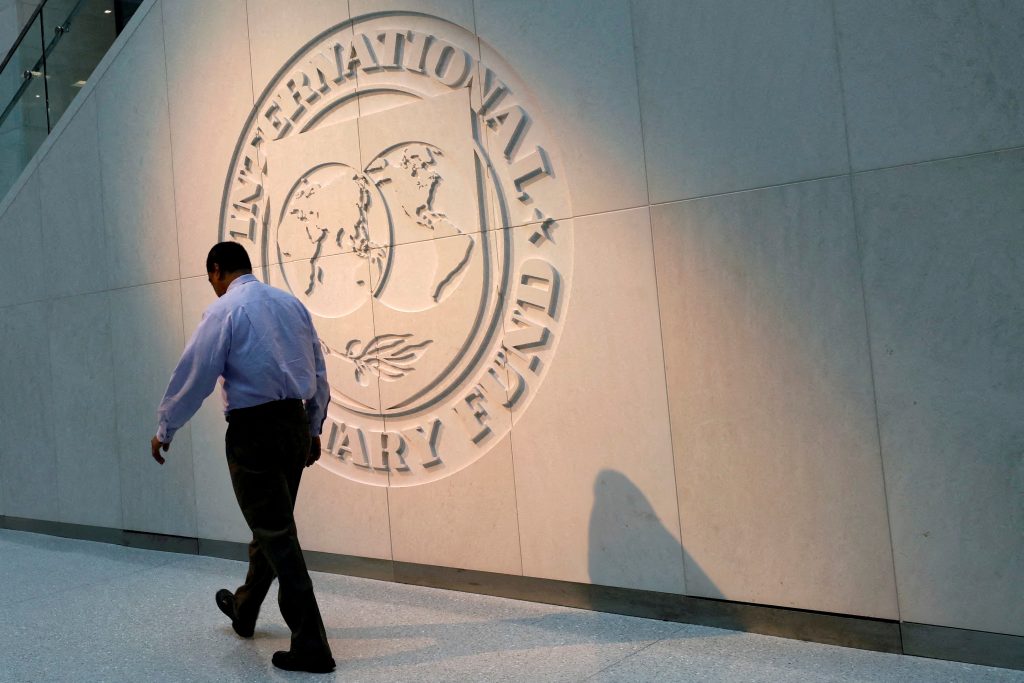 FILE PHOTO: A man walks past the International Monetary Fund (IMF) logo at its headquarters in Washington, U.S., May 10, 2018. REUTERS/Yuri Gripas
FILE PHOTO: A man walks past the International Monetary Fund (IMF) logo at its headquarters in Washington, U.S., May 10, 2018. REUTERS/Yuri Gripas The International Monetary Fund warned on Tuesday of a “perilous combination of vulnerabilities” in financial markets, saying participants’ failing to adequately prepare for interest rate increases has led to significant uncertainty about the health of the financial system.
Moreover, the global lender said U.S. regional banks in particular may warrant closer scrutiny after the largest bank collapses since the 2007-2009 financial crisis four weeks ago exposed weaknesses in a sector responsible for a sizeable share of consumer and business credit in the world’s largest economy.
In its latest Global Financial Stability Report, the IMF said global financial stability risks had increased “rapidly” in the six months since its previous assessment when it was already touting hazards as being “significantly skewed” to the downside.
Now, following last month’s sudden failures of Silicon Valley Bank and Signature Bank in the U.S., as well as the loss of confidence in Credit Suisse that forced regulators to engineer a takeover by UBS, the IMF said, “market sentiment remains fragile, and strains are still evident across a number of institutions and markets.”
“Even if you think that on average, banks have a lot of capital and liquidity, there could be these weak institutions that then spill back into the system as a whole,” said Tobias Adrian, director of the IMF’s Monetary and Capital Markets Department, in an interview.
The report, alongside an updated World Economic Outlook that flagged many of the same risks, comes roughly a year after the U.S. Federal Reserve embarked on the most aggressive course of interest rate increases in four decades, pulling other central banks along in a synchronized global policy tightening aimed at lowering inflation.
The IMF said the bank failures “have been a powerful reminder” of the challenges wrought by tighter monetary policy – and the more stringent financial conditions it generated – and the buildup in vulnerabilities since the global financial crisis more than a decade ago.
Obvious in Hindsight
Even before the recent turmoil in the banking sector there were maturity mismatches and financial leverage that have existed quietly under the surface for years, the report noted, highlighting the Bank of England’s temporary purchases to stabilize its domestic bond market and Korean authorities’ reactivating of asset purchase programs to address strains in the asset-backed commercial paper market last fall as signs of trouble.
“While risks are obvious in hindsight, the systemic implications of the existing weaknesses were largely unanticipated by policymakers and investors alike,” the report said.
Though forceful responses by policymakers have reduced market anxiety, it remains to be seen whether recent events are a “harbinger of more systemic stress,” the IMF said, noting that exposures or losses may be masked by accounting rules or regulatory treatments.
Problems at U.S. regional banks grew last year, as rapidly rising interest rates slashed the value of some banks’ holdings in long-term assets such as home loans and government bonds.
The underlying issues exploded last month when shares of SVB plunged and depositors fled after it surprised the market on March 8 with plans to raise capital to fill a nearly $2 billion hole from the sale of securities. Regulators closed the bank just two days later, and Signature was shut two days after that.
Going forward, regional banks could face greater scrutiny with respect to their holdings and funding structures, the IMF cautioned.
“Because regional and smaller banks in the United States account for more than one-third of total bank lending, a retrenchment from credit provision could have a material impact on economic growth and financial stability,” the report said.
Shoring up ‘Trust’
U.S. regulators acted quickly to backstop all deposits at SVB and Signature Bank, even those beyond the Federal Deposit Insurance Corp’s limit, stabilizing deposit outflows at smaller lenders.
Even still, authorities should be more prepared to deal with financial instability, the IMF recommended, including by strengthening their bank resolution regimes.
“The international community will need to take stock of these experiences and draw policy conclusions on the effectiveness of resolution reforms after the global financial crisis,” the report said.
Adrian added the IMF will be watching “very closely” to see whether “the central banks have the tools to make sure that trust remains in the system.”
While households and businesses accumulated buffers during the pandemic that boosted their shock-absorbing capacity, those cushions have deteriorated as interest rates have risen, the IMF said, leaving them “more vulnerable to default risk.”
A decline in revenues and tighter funding conditions from banks could expose large firms to downgrade risks, particularly for large firms in emerging markets, the report said.
Elsewhere, the IMF highlighted several other sources of potential macroeconomic risk, including a strong reopening in China and an escalation of Russia’s war in Ukraine, which could exacerbate stubbornly high inflation.
“It’s really these weaker tails among households, corporates and countries that could then have aggregate impact at some point,” said Adrian. “At the moment we don’t see that, but as monetary policy tightening is continuing, there’s certainly a risk of that.”
(Reuters)
Inside Telecom provides you with an extensive list of content covering all aspects of the Tech industry. Keep an eye on our News section to stay informed and updated with our daily articles.